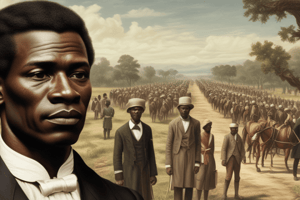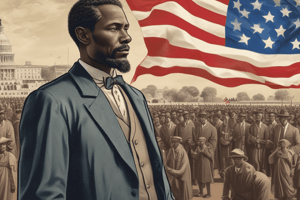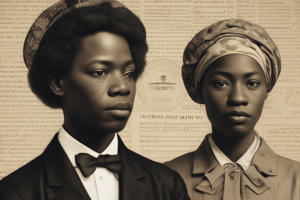Podcast
Questions and Answers
Which of the following was NOT a contributing factor to the start of World War I?
Which of the following was NOT a contributing factor to the start of World War I?
- Imperialism
- Alliances
- Nationalism
- Materialism (correct)
What was the main purpose of wartime agencies during the Great War?
What was the main purpose of wartime agencies during the Great War?
- To provide medical treatment and care for wounded soldiers
- To manage the production and distribution of essential goods and resources
- To enforce strict censorship and monitor public opinion (correct)
- To promote economic growth and job creation
What was the significance of the Zimmermann Telegram?
What was the significance of the Zimmermann Telegram?
- It prompted the United States to declare war on Germany (correct)
- It convinced Mexico to join the war on the side of the Central Powers
- It exposed a secret alliance between Germany and Japan against the United States
- It revealed Germany's intention to negotiate peace with the Allies
What event directly contributed to the United States' entry into World War I?
What event directly contributed to the United States' entry into World War I?
How did the US government finance the Great War?
How did the US government finance the Great War?
What was the primary purpose of Black Codes after the Civil War?
What was the primary purpose of Black Codes after the Civil War?
Which amendment guarantees equal protection under the law for all citizens?
Which amendment guarantees equal protection under the law for all citizens?
What was the outcome of the elections of 1866?
What was the outcome of the elections of 1866?
What did the KKK primarily aim to achieve during Reconstruction?
What did the KKK primarily aim to achieve during Reconstruction?
How was the Election of 1876 resolved?
How was the Election of 1876 resolved?
How did sharecropping create a cycle of poverty?
How did sharecropping create a cycle of poverty?
What was a significant issue with the film Birth of a Nation?
What was a significant issue with the film Birth of a Nation?
What did the term carpetbaggers refer to in the post-Civil War South?
What did the term carpetbaggers refer to in the post-Civil War South?
What were the main ideas behind Theodore Roosevelt's Square Deal?
What were the main ideas behind Theodore Roosevelt's Square Deal?
What was the initial purpose of the Women's Christian Temperance Union (WCTU)?
What was the initial purpose of the Women's Christian Temperance Union (WCTU)?
Ida Tarbell is known for her contributions to which field?
Ida Tarbell is known for her contributions to which field?
How did muckraking contribute to social reform?
How did muckraking contribute to social reform?
What was the function of political machines during the Progressive Era?
What was the function of political machines during the Progressive Era?
What were nativists primarily concerned about during the late 19th century?
What were nativists primarily concerned about during the late 19th century?
What was a key objective of the Progressive movement?
What was a key objective of the Progressive movement?
What did the Triangle Shirtwaist Factory fire prompt in American society?
What did the Triangle Shirtwaist Factory fire prompt in American society?
What was one justification for U.S. expansion in the late 19th and early 20th centuries?
What was one justification for U.S. expansion in the late 19th and early 20th centuries?
What was the main theme of the poem 'The White Man’s Burden'?
What was the main theme of the poem 'The White Man’s Burden'?
What did the Platt Amendment allow the U.S. to do in Cuba?
What did the Platt Amendment allow the U.S. to do in Cuba?
What was Dollar Diplomacy?
What was Dollar Diplomacy?
What characterized the Spanish-American War as a 'Splendid Little War'?
What characterized the Spanish-American War as a 'Splendid Little War'?
How did the U.S. acquire the Panama Canal Zone?
How did the U.S. acquire the Panama Canal Zone?
In what way was the annexation of Hawaii formalized?
In what way was the annexation of Hawaii formalized?
How did the Haymarket Affair most significantly impact the labor movement in the United States?
How did the Haymarket Affair most significantly impact the labor movement in the United States?
What was a key feature of the corporation model of business organization that emerged during the Gilded Age?
What was a key feature of the corporation model of business organization that emerged during the Gilded Age?
What was the main goal of the Progressive Era reforms known as initiative, referendum, and recall?
What was the main goal of the Progressive Era reforms known as initiative, referendum, and recall?
Which of the following best describes the term 'Gilded Age'?
Which of the following best describes the term 'Gilded Age'?
What was the primary reason for the Great Migration of African Americans from the South to the North?
What was the primary reason for the Great Migration of African Americans from the South to the North?
What was the primary focus of Margaret Sanger's advocacy?
What was the primary focus of Margaret Sanger's advocacy?
Which of the following is a tactic commonly employed by labor unions in conflicts with management?
Which of the following is a tactic commonly employed by labor unions in conflicts with management?
What was the main theme of Upton Sinclair's novel The Jungle?
What was the main theme of Upton Sinclair's novel The Jungle?
What did the Elkins Act of 1903 aim to accomplish?
What did the Elkins Act of 1903 aim to accomplish?
What was the main reason behind the creation of the Federal Reserve System in 1913?
What was the main reason behind the creation of the Federal Reserve System in 1913?
In the context of labor conflicts, what is meant by a closed shop?
In the context of labor conflicts, what is meant by a closed shop?
Which of the following best summarizes Carnegie's Gospel of Wealth?
Which of the following best summarizes Carnegie's Gospel of Wealth?
Which of these was NOT a common tactic used by management to resist union demands?
Which of these was NOT a common tactic used by management to resist union demands?
What was the main reason why the American Federation of Labor (AFL) was more successful than the Knights of Labor during the Industrial Era?
What was the main reason why the American Federation of Labor (AFL) was more successful than the Knights of Labor during the Industrial Era?
What is meant by the term laissez-faire in relation to economic policy?
What is meant by the term laissez-faire in relation to economic policy?
Flashcards
What are Black Codes?
What are Black Codes?
Laws passed in the South after the Civil War to limit Black people's rights and enforce racial segregation.
What was significant about the 1866 elections?
What was significant about the 1866 elections?
The 1866 elections gave Republicans control of Congress, allowing them to override President Johnson's vetoes and advance Reconstruction.
What was a primary goal of the KKK during Reconstruction?
What was a primary goal of the KKK during Reconstruction?
The KKK aimed to maintain white supremacy by using violence and intimidation against Black people.
How was the Election of 1876 resolved?
How was the Election of 1876 resolved?
Signup and view all the flashcards
What did white southerners call opportunistic Northerners who came to the South?
What did white southerners call opportunistic Northerners who came to the South?
Signup and view all the flashcards
How was sharecropping often a cycle of poverty?
How was sharecropping often a cycle of poverty?
Signup and view all the flashcards
What did the 13th Amendment do?
What did the 13th Amendment do?
Signup and view all the flashcards
Why was the film "Birth of a Nation" controversial?
Why was the film "Birth of a Nation" controversial?
Signup and view all the flashcards
What was the Zimmermann Telegram?
What was the Zimmermann Telegram?
Signup and view all the flashcards
What happened to the Lusitania?
What happened to the Lusitania?
Signup and view all the flashcards
What happened in East St. Louis in 1917?
What happened in East St. Louis in 1917?
Signup and view all the flashcards
What decision by Germany ultimately led to the US entering the war?
What decision by Germany ultimately led to the US entering the war?
Signup and view all the flashcards
How did the Federal government finance the Great War?
How did the Federal government finance the Great War?
Signup and view all the flashcards
Radical Republican Reconstruction
Radical Republican Reconstruction
Signup and view all the flashcards
Sherman's Field Order No. 15
Sherman's Field Order No. 15
Signup and view all the flashcards
Closed Shops
Closed Shops
Signup and view all the flashcards
Tammany Hall
Tammany Hall
Signup and view all the flashcards
Philanthropy
Philanthropy
Signup and view all the flashcards
Carnegie's Gospel of Wealth
Carnegie's Gospel of Wealth
Signup and view all the flashcards
Haymarket Square Riot
Haymarket Square Riot
Signup and view all the flashcards
The Gilded Age
The Gilded Age
Signup and view all the flashcards
The Great Migration
The Great Migration
Signup and view all the flashcards
Corporation Model of Business
Corporation Model of Business
Signup and view all the flashcards
Federal Reserve System
Federal Reserve System
Signup and view all the flashcards
American Federation of Labor (AFL)
American Federation of Labor (AFL)
Signup and view all the flashcards
Laissez-faire
Laissez-faire
Signup and view all the flashcards
Progressive Era Reforms: Initiative, Referendum, Recall, Direct Primary
Progressive Era Reforms: Initiative, Referendum, Recall, Direct Primary
Signup and view all the flashcards
What was Theodore Roosevelt's Square Deal?
What was Theodore Roosevelt's Square Deal?
Signup and view all the flashcards
What was the goal of the Woman's Christian Temperance Union?
What was the goal of the Woman's Christian Temperance Union?
Signup and view all the flashcards
Who was Ida Tarbell?
Who was Ida Tarbell?
Signup and view all the flashcards
What is muckraking?
What is muckraking?
Signup and view all the flashcards
How was Lewis Hines a muckraker?
How was Lewis Hines a muckraker?
Signup and view all the flashcards
How was Jacob Riis a muckraker?
How was Jacob Riis a muckraker?
Signup and view all the flashcards
How was Upton Sinclair a muckraker?
How was Upton Sinclair a muckraker?
Signup and view all the flashcards
Who was William Tweed?
Who was William Tweed?
Signup and view all the flashcards
How did a political machine work?
How did a political machine work?
Signup and view all the flashcards
What event/issue were nativists most concerned with?
What event/issue were nativists most concerned with?
Signup and view all the flashcards
What were some of the goals of Progressives and Populists?
What were some of the goals of Progressives and Populists?
Signup and view all the flashcards
What are some of the eventual successes of the Populists?
What are some of the eventual successes of the Populists?
Signup and view all the flashcards
What are some examples of legislation that began to regulate business?
What are some examples of legislation that began to regulate business?
Signup and view all the flashcards
What happened at the Triangle Shirtwaist Factory?
What happened at the Triangle Shirtwaist Factory?
Signup and view all the flashcards
What were some of the rationales/justifications for US expansion in late 19th and early 20th Centuries?
What were some of the rationales/justifications for US expansion in late 19th and early 20th Centuries?
Signup and view all the flashcards
Study Notes
Reconstruction Era
- Black Codes and Jim Crow laws were implemented in the US South to restrict Black rights and limit their power.
- Post-Civil War, these codes severely limited Black people's rights, often relating to voting, employment, and property ownership.
- Suffrage (voting rights) denial occurred for various reasons, including lack of wealth, property, or education. Constitutional laws sometimes barred citizens as well.
- 1866 elections ended presidential Reconstruction and empowered Radical Republicans, setting up Congressional Reconstruction.
- The KKK aimed to undermine the Republican Party and maintain white supremacy during Reconstruction.
- The Compromise of 1876 resolved the disputed election via the withdrawal of federal troops from the South, effectively ending Reconstruction
- "Carpetbaggers" was a derogatory term for opportunistic Northerners who migrated to the South after the Civil War
- Sharecropping often trapped African Americans in cycles of debt and poverty.
Amendments
- 13th Amendment: Abolished slavery.
- 14th Amendment: Guaranteed equal protection under the law for all citizens.
- 15th Amendment: Prohibited voting discrimination based on race.
- 16th Amendment: Authorized federal income tax.
- 17th Amendment: Established direct election of Senators by popular vote.
- 18th Amendment: Prohibited the manufacture, sale, and transport of alcohol (Prohibition).
- 19th Amendment: Granted women the right to vote.
- 21st Amendment: Repealed the 18th Amendment (ended Prohibition).
Progressive Era
- Birth of a Nation film: Controversial for its portrayal of African Americans as inferior and positive illustrations of the KKK.
- Radical Republicans: Advocated harsh punishments for Confederate states and government intervention to secure Black civil rights during Reconstruction.
- General Sherman's Field Order No. 15: Set aside land for distribution to African Americans.
- Closed shops: Businesses that only hire union members.
- Tammany Hall: Powerful political machine led by "Boss" Tweed.
- Philanthropy: Promoting the welfare of others through charitable donations.
- Carnegie's Gospel of Wealth: Wealthy Americans had a responsibility to use their fortune for the common good.
- Haymarket Square: Violent incident between police and labor protesters, which increased anti-labor sentiment.
- Gilded Age: Period of extreme wealth and corruption masking underlying social problems due to materialism.
- Great Migration: Large-scale movement of African Americans from the South to Northern, Midwestern, and Western states (1910s-1970s). Connected to race riots in northern cities caused by white social and economic anxieties.
- Corporation model: Separates ownership from management; Advantages include: raised capital through stock sales, reduced risk (limited liability), and no single owner limitation.
- Federal Reserve System: Created by Woodrow Wilson, the central banking system of the US.
- Union conflicts—management tools: Scabs, Pinkertons, lockouts, blacklisting, and court injunctions.
- Union conflicts—labor tools: Boycotts, informational picketing, closed shops, and organized strikes.
- AFL success: Focus on practical goals and the use of strikes, leveraging skilled worker status.
- Laissez-faire: Economic system with minimal government intervention in transactions between private parties.
Progressive Reforms
- Initiative: Citizens propose laws to be voted on.
- Referendum: Citizens vote directly on proposed laws or constitutional amendments.
- Recall: Voters can remove an elected official from office.
- Direct Primary: Voters directly choose their party's candidate nominations.
- Margaret Sanger: Championed birth control and women's reproductive rights.
- The Jungle: Upton Sinclair's novel about meatpacking industry working conditions, leading to the Pure Food and Drug Act.
- Factory system's impact: Centralization and division of labor.
- Elkins Act: Amended the Interstate Commerce Act to prevent railroads from giving rebates.
- Theodore Roosevelt and the Square Deal: Protection of consumers, control of corporations, conservation of resources.
Other Key Topics
- Muckrakers: Investigative journalists exposing social problems (Lewis Hines, Jacob Riis, Upton Sinclair).
- William Tweed: Corrupt politician and leader of Tammany Hall.
- Political machines: Cyclical political power structures, often using bribery to procure votes.
- Nativists: Concerned about Catholic immigration and their perceived allegiance to the Pope.
- Progressive goals: Government reform, family, and educational improvements.
- Populist goals: Collective bargaining, railroad regulation, expansionary monetary policies, and the Sub-Treasury Plan.
- Populist successes: Helped gain the right to elect US Senators.
- Business regulation legislation: Federal Trade Commission Act, Sherman Anti-Trust Act, Inspection Acts, Interstate Commerce Commission, Hepburn Act for railroads.
- Triangle Shirtwaist Factory fire: Exposed dangerous working conditions in factories.
- US Expansionism: Driven by market needs, and a belief in America's cultural superiority.
- Philippine-American War: High cost in human lives, brutal military tactics.
- "White Man's Burden": Justification for colonialism.
- Rough Riders: Famous volunteer cavalry unit led by Roosevelt in the Spanish-American War.
- Platt Amendment impact on Cuba: Limited Cuba's independence and allowed significant US involvement in Cuban affairs for the sake of enforcing Cuban independence.
- Dollar Diplomacy: American financial support for other countries to garner political favors.
- Spanish-American War: Brief conflict referred to as the "splendid little war" due to its brevity and relatively low US death toll.
- Roosevelt Corollary: Extension of Monroe Doctrine, permitting US intervention in Latin American affairs.
- Acquisition of Panama Canal Zone: Treaty with Panama granting US exclusive and permanent rights for the canal.
- Acquisition of Hawaii: Annexation by the US in 1898.
- MAIN causes of WWI: Militarism, Alliances, Imperialism, and Nationalism.
- World War I agencies: Propaganda and home-front support.
- Zimmermann Telegram: Coded message proposing alliance between Germany and Mexico against the US.
- Sinking of the Lusitania: German submarine attack on a passenger ship that played a role in US entry into WWI.
- East St. Louis riots: Racial tensions culminating in violence in 1917.
- US entry into WWI: German resumption of unrestricted submarine warfare.
- WWI financing: US government sold Liberty Bonds to raise money.
- Women's contribution to war effort (home front): Filled labor needs in roles previously held by men, joined the military, and worked in defense plants.
Studying That Suits You
Use AI to generate personalized quizzes and flashcards to suit your learning preferences.




